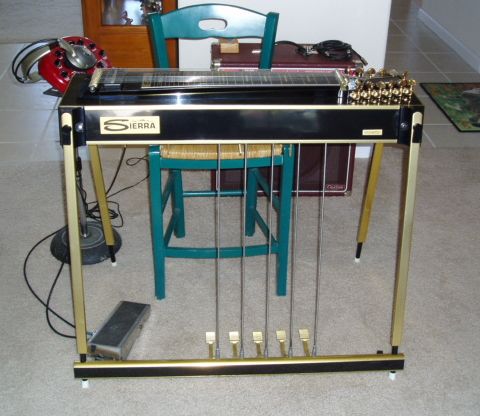Concert F Diatonic Copedent
Here's the copedent I developed for classical, new age and progressive rock music. It's a 12 string tuning based on the diatonic scale in the key of F.
| LKL | LKR | p1 | p2 | p3 | p4 | p5 | RKL | RKR | |||||||
|---|---|---|---|---|---|---|---|---|---|---|---|---|---|---|---|
| .012 | F | +F# | |||||||||||||
| .014 | E | -Eb | -Eb | ||||||||||||
| .016 | D | -Db | |||||||||||||
| .018 | C | +C# | |||||||||||||
| .020p | Bb | +B | |||||||||||||
| .022w | A | -Ab | |||||||||||||
| .024 | G | ||||||||||||||
| .026 | F | +F# | |||||||||||||
| .030 | D | +E | +Eb | ||||||||||||
| .036 | C | -B | |||||||||||||
| .042 | Bb | -A | -Ab | ||||||||||||
| .052 | F | -D | -Eb | ||||||||||||
I use the standard E9th and C6th copedents for most country, swing, blues and rock, but the F Diatonic is often my choice when I have to read music. The strings correspond directly to the notes on the written staff. I often mark up the music with fret numbers so I know when to move the bar.
Theory of Operation
The table below shows how pedal and knee lever combinations produce the key signatures of seven diatonic major scales with the bar positioned at the 7th fret (the "key of C" fret). These scales use strings 1 through 8 and have a range of one octave.
7th fret key pedal/knee scale signature combination C --- --- G 1 sharp Pedal 2 D 2 sharps Pedal 2 + LKL A 3 sharps Pedal 2 + LKL + RKR F 1 flat Pedal 3 Bb 2 flats Pedal 3 + LKR Eb 3 flats Pedal 3 + LKR + RKL
Using this tuning, I'm never more than one fret away from a full diatonic scale in any key signature at any fret. Pedals 1, 4 and 5 are used to add to the variety of foundation notes available from the bass strings.
Fine Tuning
I don't believe it's possible to tune all 7 of these diatonic scales to just intonation. Instead, I am tuning to a flavor of "meantone" temperment centered on the G note. This gets the thirds nicely in tune in all keys at the slight expense of the fourths and fifths.
| Meantone Temperment Tuning Deviation in Cents |
|
|---|---|
| Db | +15 |
| Ab | +12.5 |
| Eb | +10 |
| Bb | +7.5 |
| F | +5 |
| C | +2.5 |
| G | -0- |
| D | -2.5 |
| A | -5 |
| E | -7.5 |
| B | -10 |
| F# | -12.5 |
| C# | -15 |
Meantone is sweeter sounding than equal temperment, but not as pure as just intonation. Since only 7 of the 12 key signatures are available at any given fret, the compromise is actually a good idea.
Meantone is the temperament used for many keyboard instruments made from the 1500's through the mid-1800's. It allows 6 major keys and 3 minor keys to sound in tune on a 12-key keyboard, with sweeter harmonies than are heard on today's equally-tempered keyboards. I especially enjoy the sound of Bach's music when it is played in meantone on the F diatonic pedal steel.

This 1978 Sierra Olympic is tuned to F diatonic
| |